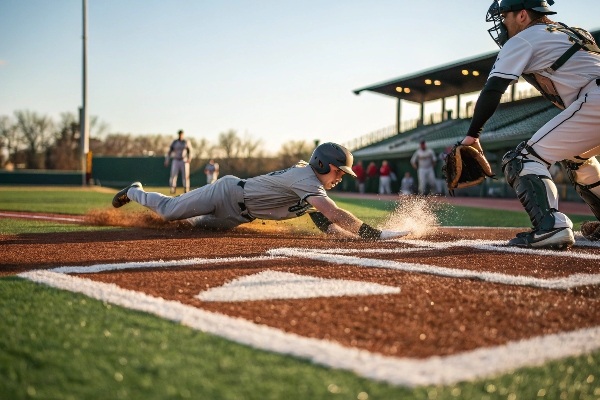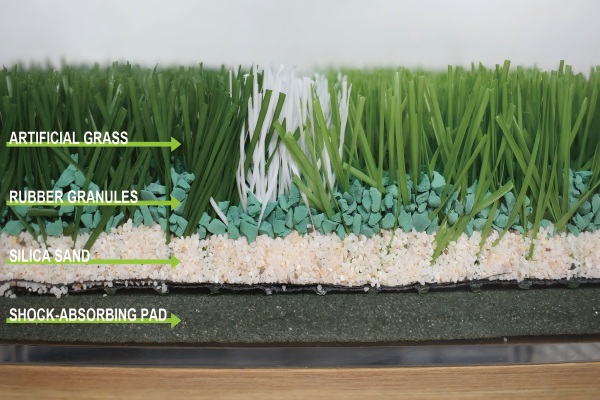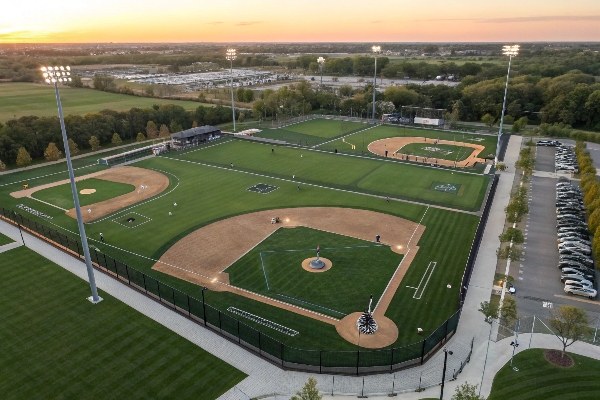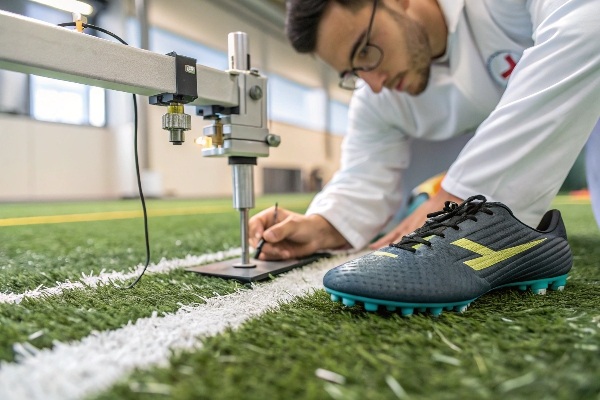Are you worried about player safety on your baseball field? An inconsistent natural field can lead to preventable injuries. Modern artificial turf offers a consistent, engineered surface to keep players safer.
Yes, high-quality modern artificial turf can reduce certain types of baseball injuries. It provides a consistent, even surface that minimizes bad hops and has superior shock absorption to cushion falls. Its excellent drainage also prevents the slippery, muddy conditions that lead to slips and falls.

The debate between natural grass and artificial turf has been going on for years. As an engineer who has worked in this industry for a long time, I’ve seen the technology evolve firsthand. The turf we produce today is a world away from the old, carpet-like fields of the past. It’s now a highly engineered system designed with player safety as a top priority. Let’s dig deeper into how exactly turf impacts player safety and performance in the great game of baseball.
How does artificial turf affect injuries?
Are you unsure how a synthetic surface really impacts a player’s body? Some older turf systems could be harsh on joints. However, today’s advanced turf systems are specifically engineered to absorb impact.
Artificial turf affects injuries by providing a controlled and consistent environment. Modern systems use specialized infill and shock-absorbing pads to reduce the force of impact on players’ joints (G-max rating1). This predictable surface also prevents the sudden stumbles and bad ball hops common on worn-out grass.

The Science of Safety: G-Max and Infill
When we talk about safety, the most important metric for an artificial surface is its G-max value. This is a measurement of shock absorption2. A very hard surface has a high G-max value, while a softer, more forgiving surface has a lower one. Natural grass is unpredictable; it can be soft and muddy one day, and hard as a rock during a dry spell. Our goal as turf engineers is to create a surface that stays within the optimal G-max range, regardless of the weather. We achieve this through a combination of the turf fibers, the infill material3 (like SBR rubber, TPE, or organic options), and often an underlying shock pad. This system works together to cushion every step, dive, and slide, protecting joints from repetitive stress and sudden impacts.
Consistency is Key
In my experience visiting fields around the world, the biggest danger on a natural grass field is its unpredictability. One area might be lush and perfect, while another is a bare patch of hard dirt. A player moving at full speed can’t adjust for these sudden changes, which is how many ankle and knee injuries occur. Artificial turf eliminates this variable. Every square inch of the field is the same. An outfielder knows exactly how the ball will bounce, and a runner knows the ground beneath their feet will be stable. This consistency allows players to perform with more confidence and less hesitation, which is itself a form of injury prevention.
| Safety Factor | Modern Artificial Turf | Natural Grass |
|---|---|---|
| Shock Absorption | Engineered & Consistent | Variable (soil, moisture) |
| Surface Uniformity | High (no bare spots) | Low (clumps, holes) |
| All-Weather Condition | Excellent Drainage | Prone to mud & puddles |
| Ball Bounce | Predictable & True | Unpredictable (bad hops) |
Is turf better for baseball?
Are you trying to decide between turf and grass for your baseball facility? The constant upkeep and weather dependency of natural grass is a huge drain on resources. Artificial turf provides a durable, high-performance solution.
For many facility managers and teams, artificial turf is better for a baseball field. It offers unmatched durability for heavy use, requires far less maintenance, and is ready for play in almost any weather. This provides a consistent playing experience and maximizes the field’s availability.

Performance and Durability
From a pure performance standpoint, modern baseball turf is amazing. The ball rolls true, and the bounces are consistent across the entire field. This is something even the best natural grass fields struggle to maintain. Infielders don’t have to worry about a routine grounder taking a bad hop off a clump of grass or a hard patch of dirt. But the biggest advantage is durability. I once worked with a client who had a beautiful grass field, but it rained for a week before a big tournament. The field was a muddy disaster, and they had to cancel the event, losing a lot of money and goodwill. An artificial turf field would have drained quickly and been ready for play within an hour of the rain stopping. It can handle back-to-back games, team practices, and even concerts without needing weeks to recover.
The Financial Advantage
Let’s talk about the business side. A natural grass field is a constant expense. You have to pay for mowing, massive amounts of water, fertilizer, pesticides, and the labor for it all. And even with all that investment, you have to limit its use to let the grass recover. Artificial turf, on the other hand, has a higher initial installation cost, but the long-term savings are significant. The maintenance is minimal—mostly brushing to keep the infill level and occasional cleaning. This lower operational cost and the ability to rent the field out for more events and more days of the year means the field generates more revenue. For schools, parks, and professional facilities, this financial reality makes turf the clear winner.
Do ACL tears happen more on turf or grass?
Is the fear of a serious ACL tear making you question turf? Many still believe that artificial surfaces are the main cause. The truth is that modern turf technology has changed the game entirely.
The data is complex, but the link between modern turf and ACL tears is weakening. While older, first-generation turf was associated with higher injury rates, new systems are designed with rotational resistance4 that closely mimics pristine natural grass, significantly closing the safety gap.

It’s Not Your Grandfather’s AstroTurf
The negative reputation of turf comes from the old systems from the 1970s and 80s. Those fields were little more than a thin layer of synthetic carpet over concrete or hard-packed gravel. They had very little give and far too much grip. When a player planted their foot and tried to pivot, the shoe would get stuck while the knee kept turning. That’s a recipe for an ACL tear. I cannot stress this enough: modern artificial turf is a completely different product. It is a multi-layered system designed for safety.
Understanding Rotational Resistance
The key concept here is "rotational resistance." You don’t want too much grip, and you don’t want too little. The ideal surface allows a player’s cleat to grip when they push off to run but to release just enough when they twist and turn. We achieve this by carefully selecting the type of turf fiber, the shape of the fiber, and the type and depth of the infill. The goal is to replicate the performance of a perfectly maintained, professional-level natural grass field. Recent studies comparing high-end modern turf to elite natural grass fields have found the non-contact injury rates to be statistically very similar. Often, a poorly maintained grass field is far more dangerous than a quality turf one.
What causes the most injuries in baseball?
Are you focused on making baseball as safe as possible? Looking only at the playing surface means you’re missing the primary causes. To truly prevent injuries, you need to see the whole picture.
The vast majority of baseball injuries are caused by overuse—especially in pitchers’ arms—and acute incidents like player collisions, sliding, and getting hit by a pitched or batted ball. While the playing surface can be a contributing factor, it is rarely the primary cause.

Overuse: The Real Epidemic
In all my years in the sports surface industry, I’ve learned that the most common and serious injuries in baseball have little to do with the ground. I’m talking about overuse injuries to the shoulder and elbow. Things like Little League Elbow and rotator cuff tears are caused by throwing too many pitches, using poor mechanics, and not getting enough rest. These are serious issues that can end a player’s career. Proper coaching, enforcing pitch counts, and focusing on strength and conditioning are the most effective ways to prevent these types of injuries. The best field in the world, whether it’s turf or grass, can’t prevent an arm injury from overuse.
The Inherent Risks of the Game
Baseball is a dynamic sport. Players are running at full speed, sliding into bases, diving for balls, and unfortunately, sometimes colliding with each other or getting hit by a 90-mph fastball. These acute injuries are simply part of the game. While you can’t eliminate them completely, a high-quality playing surface can help mitigate the damage. A predictable surface reduces the chance of a stumble leading up to a collision. A properly installed turf infield and base path can make slides smoother and safer. And most importantly, by eliminating bad hops, a quality turf infield can prevent many of those painful and dangerous ball impacts to the face and body. The field plays a crucial supporting role in a comprehensive safety plan.
Conclusion
Ultimately, high-quality artificial turf improves player safety and performance in baseball. It provides a consistent, reliable, and durable surface that helps reduce certain injuries compared to unpredictable, high-maintenance natural grass.
-
Learn about the G-max rating and its significance in measuring turf safety. ↩
-
Understand the mechanics of shock absorption and its role in injury prevention. ↩
-
Discover the various infill materials and their impact on turf performance. ↩
-
Learn about rotational resistance and its importance in preventing injuries. ↩
_画板-1.png)
_画板-1.png)